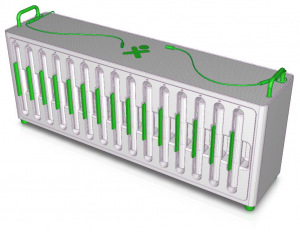Multi channel battery charger: Difference between revisions
Jump to navigation
Jump to search
| Line 14: | Line 14: | ||
== Specifications and Features == |
== Specifications and Features == |
||
* 15 batteries per unit. |
* Max of 15 batteries per unit. |
||
* Charge batteries in 2 hours |
* Charge batteries in 2 hours |
||
* AC and DC operation |
* AC (300Watt) and DC (150 Watt) operation |
||
* Operates at 50 degrees Centigrade ambient temperature |
* Operates at 50 degrees Centigrade ambient temperature |
||
* External laptop power DC cables. |
* External laptop power DC cables. |
||
Revision as of 16:06, 18 May 2008
This page is monitored by the OLPC team.
| NOTE: The contents of this page are not set in stone, and are subject to change! This page is a draft in active flux ... |
Multi Channel Battery Charger
aka the "SuperCharger"
See Product News for product availability.
Specifications and Features
- Max of 15 batteries per unit.
- Charge batteries in 2 hours
- AC (300Watt) and DC (150 Watt) operation
- Operates at 50 degrees Centigrade ambient temperature
- External laptop power DC cables.
- 2 of the XO DC power cables available to the kids so they they can power their laptops while they switch batteries. This keeps them from having to turn off the laptops to switch batteries.
- Bi-Color indicator LED per battery channel
- Red Led and Green Led. Same color setup as the XO laptop. Red, Green, and Yellow when both are enabled.
Future
- RJ45 10/100 ethernet connection
Electrical Input Requirements
- AC Power 100V-230V. 300W
- DC 10V-28V. 150W
Exterior Connections
- AC In: IEC for 120/220VAC
- DC In: 10VDC to 28VDC 2 Pin connector that mates with whats on the GP solar blanket.
- USB B connector (Its a USB device)
- 2 cables with XO DC jacks on them
Electrical Misc
- The CPU is an Atmel At91SAM7x family part.
- The per battery DC-DC charger is a SEPIC design based around a MicroChip MCP1631 part
Software
- Forth/C combination.
- http://dev.laptop.org/git?p=projects/supercharger;a=summary
Mechanical
- Density. Getting as many batteries as possible in as small a footprint is a goal.
- Physical Safety. Its got to be stable and hold lots of heavy batteries but not be able to fall over on top of a child. Who might be trying to climb on it to get his battery.
- Stackable. More vertical space is available than floor sq footage so an idea was to make them stackable. But see above point.
- Heat dissipation. Each power supply stage is about 85% and there are 2 stages for a total efficiency of 72% So while on DC heat dissipation will be around 58 Watts and on AC around 88 Watts.
- Enclosure. Metal. Except perhaps for some plastic for the battery holder. Having metal available to heatsink to should help in keeping the electronics from burning up in hot countries.
Datasheets
- File:At91sam7x128 256 pc.pdf Atmel CPU
- File:DS2756.pdf DS2756
